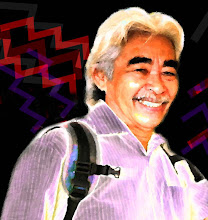 In the not too distant past, the Kayans of Sarawak used to inter ( bury) their dead in special burial huts called " Salong". Today while visiting the Sarawak Museum grounds, I had a closer look at two tall Salongs, made from the hardest timber of Sarawak called the 'belian'. Both are at least 10 meters high and have been brought to the museum gardens from their original locations hundreds of kilometers away in the interior regions of Sarawak.
In the not too distant past, the Kayans of Sarawak used to inter ( bury) their dead in special burial huts called " Salong". Today while visiting the Sarawak Museum grounds, I had a closer look at two tall Salongs, made from the hardest timber of Sarawak called the 'belian'. Both are at least 10 meters high and have been brought to the museum gardens from their original locations hundreds of kilometers away in the interior regions of Sarawak.There was one that is constructed as a single pole and another as a double pole.



 Above is a picture of the Sarawak Museum's original building dated 1891. Over time the Museum authorities added more buildings, offices etc., to house more collections to cover archaelogical and anthropological artifacts, artworks, etc., Today the Museum is a must visit place for tourists or local visitors to Kuching.
Above is a picture of the Sarawak Museum's original building dated 1891. Over time the Museum authorities added more buildings, offices etc., to house more collections to cover archaelogical and anthropological artifacts, artworks, etc., Today the Museum is a must visit place for tourists or local visitors to Kuching.
( Inset is painting of a Kenyah warrior with his head trophies)

Single Pole "Salong"

Double Trunk " Salong"
This double trunk "Salong" was originally erected more than 150 years ago on the banks of Long Segaham, above the town of Belaga in Sarawak. This burial hut was ordered to be built by the chief of the Kayan tribe in Belaga to inter his young daughter named Lisan. It was reported that it took five craftsmen plus many helpers and five years to complete the carvings on the solid 'belian' tree trunks. In 1973, the "Salong" were presented by the people of Belaga to the Sarawak Museum.

Close Up of the "Salong" or Burial Hut
 Above is a picture of the Sarawak Museum's original building dated 1891. Over time the Museum authorities added more buildings, offices etc., to house more collections to cover archaelogical and anthropological artifacts, artworks, etc., Today the Museum is a must visit place for tourists or local visitors to Kuching.
Above is a picture of the Sarawak Museum's original building dated 1891. Over time the Museum authorities added more buildings, offices etc., to house more collections to cover archaelogical and anthropological artifacts, artworks, etc., Today the Museum is a must visit place for tourists or local visitors to Kuching.




















